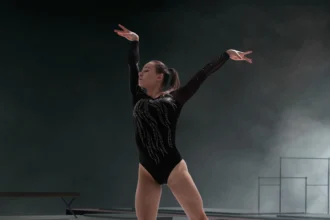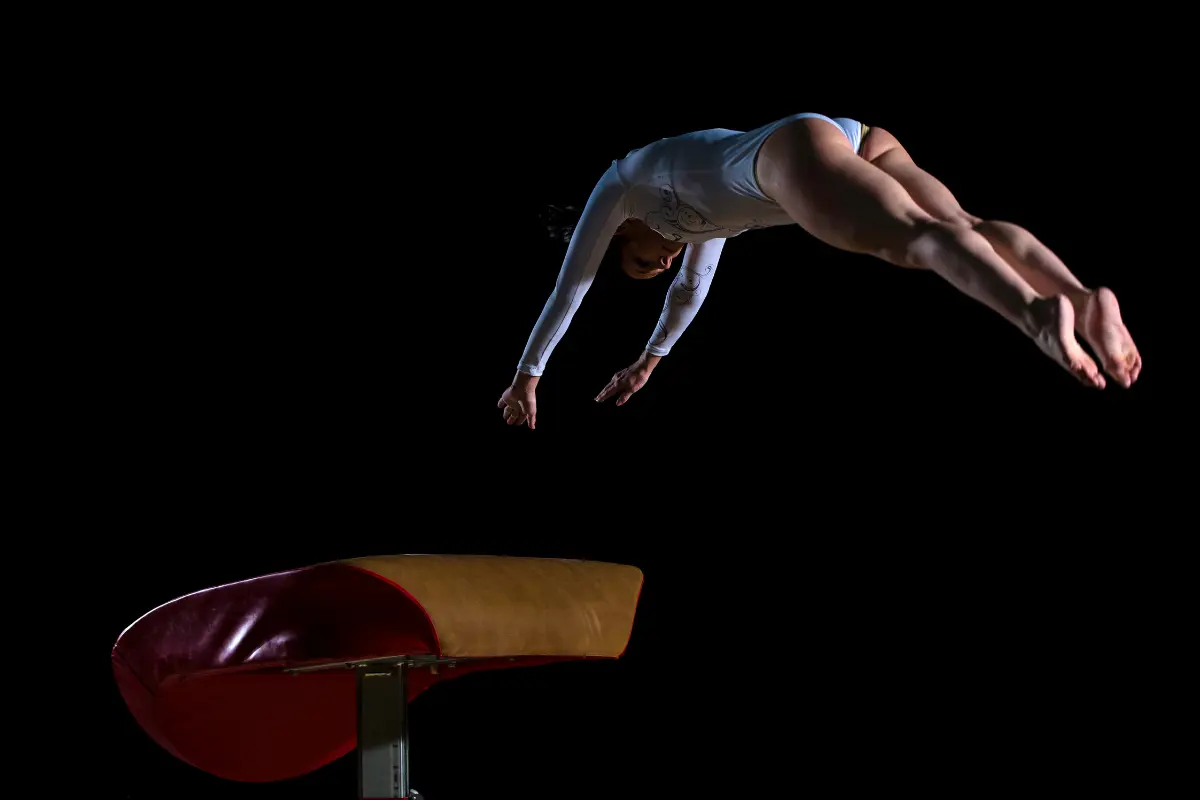The Yurchenko Double Pike is a game-changing vault in women’s gymnastics, known for its jaw-dropping difficulty and stunning execution. First introduced by Simone Biles in competition, this vault has quickly become a symbol of strength, precision, and innovation in the sport.
Next, we’ll explore what makes this vault so challenging, the history behind it, and why it continues to be a defining move in women’s gymnastics.
What is the Yurchenko Double Pike Vault?
The Yurchenko vault, first introduced by Soviet gymnast Natalia Yurchenko in the 1980s. It begins with a round-off onto the vault table, followed by a back handspring that propels the gymnast into the air. This technique significantly increased the power and height that gymnasts could generate compared to previous vaulting methods.
The Yurchenko Double Pike, however, didn’t appear until the late 2010s. The most well-known gymnast to master the Yurchenko Double Pike is American gymnast Simone Biles. Biles became the first woman to perform this vault in competition at the 2021 Tokyo Olympics trials.
The gymnast begins with the same round-off and back handspring but adds a second, highly challenging element: two somersaults in the air, executed in a pike position. In this position, the gymnast bends at the waist, keeping their legs straight and their body tightly compact.
How to Perform the Yurchenko Double Pike Vault?
Here’s the step-by-step breakdown of key components:
- Round-off and Back Handspring: The vault begins with a round-off onto the springboard, which allows the gymnast to generate significant momentum. The round-off is followed by a back handspring onto the vaulting table, which provides the gymnast with the necessary rebound for the next phase of the vault.
- Double Somersaults (Tuck to Pike Transition): After pushing off the vaulting table, the gymnast must perform two flips in the air, executing them in the pike position. This requires immense strength in the core and legs to initiate and control the flips while keeping the body in a compact position.
- Pike Position: In the pike position, the gymnast must maintain a tight form—legs straight and together, and their torso bent at the hips. This position is crucial for the gymnast to generate enough rotational speed to complete the two somersaults in the air.
- The Landing: After completing the double pike flips, the gymnast must land on the mat with precise control. The landing is one of the most challenging aspects, as it requires a perfect balance of power, speed, and technique. Any deviation from the ideal position, such as stepping or stumbling, will result in deductions from the score.
Difficulty Score of the Yurchenko Double Pike
The difficulty score (D-score) is assigned based on the complexity of the vault, and the Yurchenko Double Pike has one of the highest D-scores in gymnastics history. As of 2024, it holds a D-score of 6.4, making it one of the most difficult vaults ever performed in women’s gymnastics.
Gymnasts who perform the Yurchenko Double Pike successfully can earn a significantly higher score compared to others performing lower-difficulty vaults. However, the risk factor remains high—any mistake, whether in execution or landing, can result in severe deductions that may impact the gymnast’s overall score.
Why Is the Yurchenko Double Pike So Difficult?
The Yurchenko Double Pike is one of the hardest vaults in women’s gymnastics, and for good reason. It requires a unique blend of strength, speed, precision, and control. Here’s why it’s so challenging:
1. Power and Speed
The vault starts with a round-off onto the springboard, followed by a back handspring onto the vaulting table. To pull off the double pike, the gymnast needs a huge amount of speed and power just to push off the table high enough to complete the two flips in the air. Without the right momentum, the vault won’t have enough height or rotation, which can make it impossible to finish.
2. Two Somersaults in the Air
The gymnast has to do two flips in the air while holding a pike position, which means bending at the waist with straight legs. This is tough because staying compact while spinning is key to getting the right rotation. If the gymnast opens up too early or doesn’t flip fast enough, she could end up under-rotating or over-rotating, leading to a mistake or fall.
3. Air Awareness
When performing this vault, gymnasts need to be super aware of their body position in the air. They have to know when to open up and get ready for the landing. If they don’t spot the ground at the right moment, they might land too early or too late, which can cause a messy or risky landing.
4. Perfect Landing
The landing is one of the trickiest parts of the Yurchenko Double Pike. The gymnast has to land with her body fully extended, with her legs straight and locked, to avoid deductions. Even a small mistake—like stepping out of bounds or wobbling—can cost valuable points. The ability to land perfectly, without any imbalance, is crucial for a good score.
5. Risk of Injury
Because of how powerful and complex the Yurchenko Double Pike is, there’s a higher risk of injury. A wrong move, especially during the landing or while rotating, can lead to serious harm. Only the most experienced gymnasts, like Simone Biles, attempt this vault because of the risks involved.
6. Mental Focus
Finally, executing such a difficult vault requires incredible mental focus. The gymnast has to trust her skills and block out any fear or hesitation. Any doubts can throw off the timing, making it harder to execute the vault successfully.
Biles’ Performances of the Yurchenko Double Pike
The Yurchenko Double Pike is a groundbreaking vault in women’s gymnastics that has only been performed by Simone Biles at the highest level. Her flawless execution of this incredibly difficult vault continues to captivate gymnastics fans around the world.
Here’s a closer look at some of her most significant performances:
2021 U.S. Olympic Trials
Biles first introduced the Yurchenko Double Pike to the gymnastics world during the 2021 U.S. Olympic Trials, where she made her mark as the first woman ever to perform this vault in competition. The vault was a jaw-dropping moment that left the gymnastics community in awe of her power, technique, and the sheer difficulty of the move.
This performance, which took place at the Dickies Arena in Fort Worth, Texas, not only set the stage for her Olympic journey but also made a definitive statement about her ability to push the boundaries of the sport.
- Date: June 2021
- Event: U.S. Gymnastics Olympic Trials
- Location: Fort Worth, Texas
- Vault Performed: Yurchenko Double Pike
- Significance: First-ever performance of the Yurchenko Double Pike in competition
2022 World Championships (Liverpool)
Biles continued her mastery of the Yurchenko Double Pike at the 2022 World Gymnastics Championships in Liverpool, where she not only performed the vault with unparalleled precision but also set the record for the highest score ever achieved in women’s vault.
Her stunning execution earned her a score of 15.633, which remains the highest recorded vault score in women’s gymnastics. This performance further solidified her position as the leading figure in women’s gymnastics and set a new standard for difficulty in vaulting.
- Date: October 2022
- Event: World Gymnastics Championships
- Location: Liverpool, England
- Vault Performed: Yurchenko Double Pike
- D-Score: 6.4
- Total Score: 15.633
- Significance: Highest vault score ever recorded for a woman in gymnastics
2023 World Championships (Antwerp)
At the 2023 World Gymnastics Championships in Antwerp, Simone Biles once again performed the Yurchenko Double Pike, reaffirming her dominance in the vault event. Her flawless execution of this vault proved that she had not only mastered the skill but also consistently delivered it at the highest level.
This performance was particularly significant as Biles returned to the World Championships after a hiatus, demonstrating her unmatched consistency and ability to perform under pressure.
- Date: October 2023
- Event: World Gymnastics Championships
- Location: Antwerp, Belgium
- Vault Performed: Yurchenko Double Pike
- Significance: Continued to demonstrate the precision and consistency of Biles’ execution of the Yurchenko Double Pike
Biles’s ability to execute this vault with flawless precision has earned her a place in gymnastics history, not only as the first woman to perform it but also as the gymnast who continues to raise the bar for future generations. The Yurchenko Double Pike has become synonymous with Biles’ legacy, marking her as one of the greatest gymnasts of all time.




